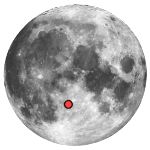Albategnius (crater)

| Diameter | 129 km |
|---|---|
| Depth | 4.4 km |
| Colongitude | 356° at sunrise |
| Eponym | Al-Batani |
Albategnius is an ancient lunar impact crater located in the central highlands. It is named after the Latin nickname for the Muslim astronomer and scientist Muhammad ibn Jābir al-Harrānī al-Battānī.
Description
The level interior of Albategnius forms a walled plain, surrounded by the high, terraced rim. The outer wall is somewhat hexagon-shaped, and has been heavily eroded with impacts, valleys and landslips. It attains a height above 4,000 metres along the northeast face. The rim is broken in the southwest by the smaller crater Klein.
Offset to the west of the crater's midpoint is its central peak, designated Alpha (α) Albategnius. It is longest in extent in the north-south direction, extending for just under 20 kilometres, and has a width about half that. The peak rises to an altitude of roughly 1.5 km, and there is a tiny, relatively fresh crater at the top.
Location
Albategnius is located to the south of the crater Hipparchus and to the east of Ptolemaeus and Alphonsus. The surface in this area is marked by a set of nearly parallel scars that form channels running roughly in a north-south line, bent slightly to the southeast.
Observations
Albategnius is believed to have been featured prominently in an early sketch drawing by Galileo in his book Sidereus Nuncius published in 1610, appearing along the lunar terminator.
Names
Albategnius is named after the astronomer of the same name. Like many of the craters on the Moon's near side, it was given its name by Giovanni Riccioli, whose 1651 nomenclature system has become standardized.[1] Earlier lunar cartographers had given the feature different names. Michael van Langren's 1645 map calls it "Ferdinandi III Imp. Rom." after Ferdinand III, the Holy Roman Emperor.[2] And Johannes Hevelius called it "Didymus Mons".[3]
Satellite craters
By convention these features are identified on lunar maps by placing the letter on the side of the crater midpoint that is closest to Albategnius.
| Albategnius | Latitude | Longitude | Diameter |
|---|---|---|---|
| A | 8.9° S | 3.2° E | 7 km |
| B | 10.0° S | 4.0° E | 20 km |
| C | 10.3° S | 3.7° E | 6 km |
| D | 11.3° S | 7.1° E | 9 km |
| E | 12.9° S | 6.4° E | 14 km |
| G | 9.4° S | 1.9° E | 15 km |
| H | 9.7° S | 5.2° E | 11 km |
| J | 11.1° S | 6.2° E | 7 km |
| K | 9.9° S | 2.0° E | 10 km |
| L | 12.1° S | 6.3° E | 8 km |
| M | 8.9° S | 4.2° E | 9 km |
| N | 9.8° S | 4.5° E | 9 km |
| O | 13.2° S | 4.2° E | 5 km |
| P | 12.9° S | 4.5° E | 5 km |
| S | 13.3° S | 6.1° E | 6 km |
| T | 12.6° S | 6.1° E | 9 km |
